Let’s look back. Could it be that the world’s first presentation of a dia-compact monoblock milling cutter for aluminium machining at FAMETA in 1980 already laid the foundation for large-scale use within the automobile industry in the 80s? Actually yes, if the aforementioned “stumbling blocks” were not there (see part 7 of this article
series “Poly – poly – or what?”).
As we know, the wood and plastic manufacturing industries were already several steps ahead in this regard – especially when focussing on manufacturers of kitchen and other furniture, laminate flooring, and door and particle board industries. One obvious advantage for industrial mass production was the diamond cutting edge, soldered tightly to the carrier, creating quasi-monoblock tools. Without the need to re-tip used cutters with carbide plates after each shift, the dia-compact tool could show its full capacity – 250 to 300 times longer tool times, compared to
carbide, became a calculable reality. No wonder that the related machine industry – particularly manufacturers of routing machines and double end tenoners embraced this new technology enthusiastically.
In the 1980s and 1990s, European trade shows (in Hanover and Milan) and shows in the U.S. (IWF in Atlanta in particular) presented, parallel to the developments of NC/CNC technology, amazing performance increases every two
years. This was one side of the story. The company Lach-Spezial-Werkzeuge GmbH, founded 40 years ago, as well as
Lach Diamond Inc., Grand Rapids, Michigan, can pride themselves as the worldwide only pioneers when implementing the idea “diamond for all wood and plastic materials”.
You may now ask me about Lach Diamant, the longstanding company dedicated to metal machining. Analogous to a rising demand for “precision and efficiency,” sales – in other words revenue – steadily increased from one year to the next, more or less evenly divided between the polycrystalline diamond and CBN tool program, diamond and CBN
grinding wheels, diamond dressing tools and more for the demand in the automobile and airplane industries, machine and tool industry.
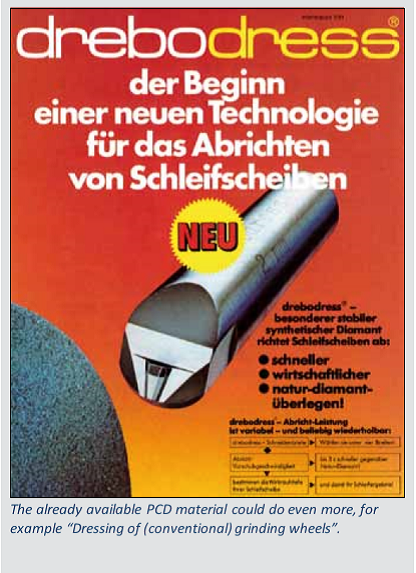
But I often bemoaned the not-yet-existing use and therefore sales potential of diamond monoblock milling machines for the automotive industry. Was this a “toothless tiger?” Did we already miss this chance due to the development of PCD inserts for use on cutter heads, which started almost a decade ago?
As so often in life – and when contemplating our “pioneering beginnings” – a lucky coincidence proved to be helpful. Although the core of the solution was so near, even if it would not necessarily be most expedient to “aluminium
machining.”
“Yes – almost Aluminium” – “No – Machining”
In any case another topic for “Poly, poly or what?” I only had to put two and two together. Diamond milling cutters – also with profiled cutting edges and axis angles – already were inevitably starting to be established as superior machining tools in the wood and composite industry. The first presentation of a profiled PCD monoblock milling cutter at FAMETA 1980 put a “dot on the i” and created the basis for future use in the automotive industry. However, the PCD material could do even more: For example, it could be used for dressing conventional grinding wheels.
The combination of two PCD tools, both first presented at this trade show, caused a stir. One was the dia-compact monoblock milling cutter for machining aluminium with high silicon content, the other trade fair novelty drebodress with the slogan “the beginning of a new technology for dressing grinding wheels.” All in all, this was the birth hour of “mill dressing” for dressing conventional grinding wheels; an international patent was pending and promoted under the proprietary name drebojet. By the way, the European patent No_0038929, registered on April 30, 1980, did not only protect the dressing roll drebojet but also drebobloc, the PCD dressing block which was named at the same time.
Lach Diamant first presented this new technology for dressing and profiling conventional grinding wheels at EMO 1981 in Hanover. A video about milling dressing with drebojet also premiered at this trade show. You can watch it at
https://vimeo.com/207282861.
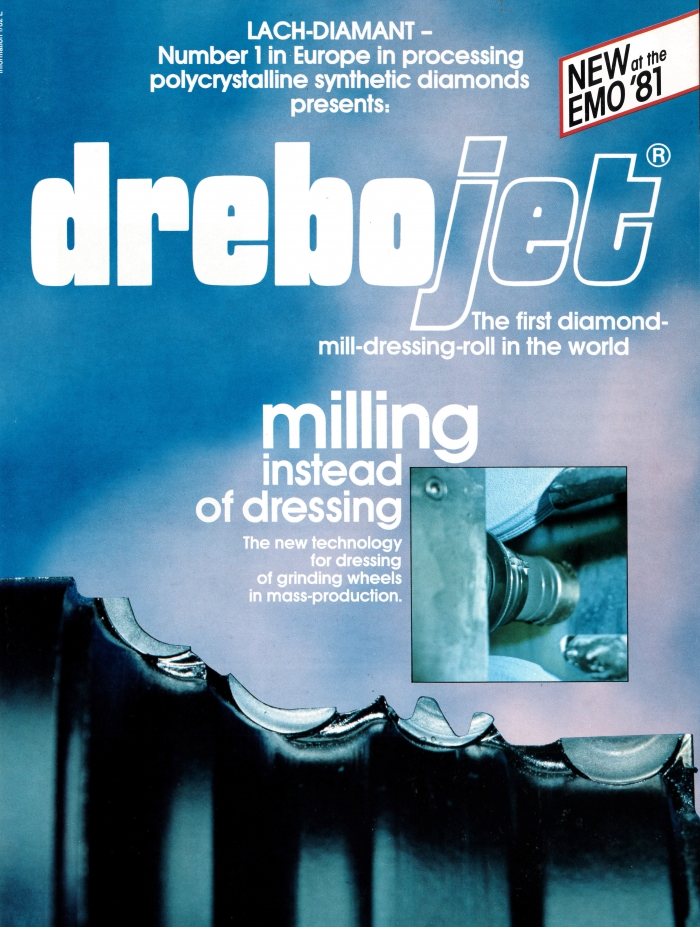
Out of many press publications from that time, two excerpts should be mentioned: “The area ‘Research and Technology’ in hall 7 at Hanover Trade Show 1982, featured the best inventions submitted for the Inventor’s Prize 1982. drebojet, technologically worldwide an absolute novelty tool based on synthetic diamonds for serial dressing of grinding wheels, particularly for use in the automotive and automotive accessories industry, submitted by innovator Horst Lach, CEO and co-owner of the Hanau enterprise Lach Diamant – Jakob Lach GmbH & Co. KG, was one of them. The drebojet diamond mill dressing roll, first presented during the international machine tool exhibition EMO in Hanover in the autumn of 1981, provides a new technology for serial dressing of grinding wheels in serial production. So far, with diamond dressing rolls, the profile of e.g. a crankshaft had to be tediously worked into a grinding wheel in 20 minutes or more; now this takes a maximum of 120 seconds.” (see Hanauer Anzeiger of May 5, 1981).
“Dressing becomes a milling procedure. Conventional diamond dressing rolls will be manufactured in different
procedures and in multiple precision stages. They all have one thing in common: Their shape, no matter which
geometry, is a closed shape. The diamond mill dressing roll in the picture is different in this regard. As during milling, the ‘chip space,’ placed intermittently between the cutting teeth, allow for maximum insertion into the grinding wheel […]. Afterwards, the milled grinding tools are – unlike in previously known dressing methods – completely stable and available for the next grinding operation. […] By changing the cutting speed of the diamond milling roll, it is also possible to influence the subsequent surface roughness of a grinding wheel dressed in this way. […]” (see Der Betriebsleiter of November 1981).
“Milling instead of conventional dressing of grinding wheels!”
This was the slogan which caught on like wildfire after the first presentations of drebojet at EMO 1981. A milling cutter tipped with PCD in competition to traditional diamond dressing rolls? A challenge – especially for the worldwide very few diamond tool manufacturers who had been involved in design and production of diamond dressing rolls.
The implementation of the milling technique could possibly multiply the number of roll manufacturers, particularly in an industry that had up to this date nothing to do with dressing grinding wheels: Namely all carbide tool manufacturers and sharpening companies, all of which were just beginning to profit from the success of diamond tools in the wood industry. At that time also, the leading manufacturer of super abrasives, General Electric, took notice of the demonstrated success of polycrystalline cutting materials in the wood and plastic industries. So it was not surprising at all that, even before EMO 1981, I received a personal invitation from Louis Kapernaros, general manager at GE Superabrasives, and was asked to present all our special activities in the U.S.
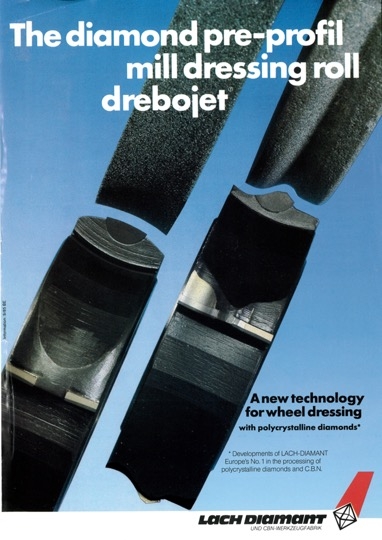
The start of a long friendship
There were a lot of wishes from our side. For example, the provision of larger PCD circular blanks. Up to this point, we had to be content with blade lengths of maximum 10-13 mm, for tool production, and cut from 13 mm blanks with EDM wire (keyword: overlapping cutting edges). Even in retrospect, I can say that this meeting with Louis Kapernaros was very successful. For General Electric and the subsequent development of further PCD sizes and types, as well as regarding the following decadelong, intensive cooperation with Lach Diamant. Ultimately, these conversations were the start of a long friendship with an always pleasant and cultivated conversation partner.
After the presentation, I was promised full support by the entire General Electric staff for R&D for the drebojet mill dressing project. I will later get back to other results from this visit. Support for R&D – knowledgeable readers will have guessed this already – there was something else! The previously mentioned article in the magazine “Der Betriebsleiter” suggested this already. And here it comes: “The issue with the comma.”
“Chip spaces” between individual teeth – or the distance from tooth to tooth – cause an unwelcome and unacceptable “comma” during plunging when milling or otherwise machining a grinding wheel. This is independent of the milling direction (see illustration below).
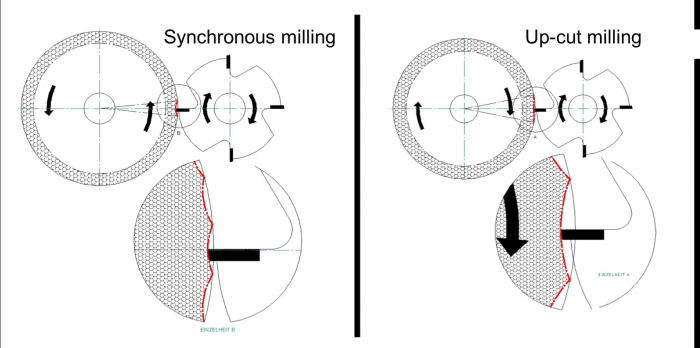
What now – what to do?
As chance would have it, I met Dr.-Ing. Günter Warnecke in early 1982. At that time, he was preparing for a new position as professor at University of Kaiserslautern (chair of production technology and business organization). It goes without saying that we started discussing dressing of grinding wheels with rolls and we also talked about my new, patent-pending idea of mill dressing. First tests at Elb-Schliff in Babenhausen, at that time a leading manufacturer of surface grinding machines, had already provided advantageous insights. For example, that up-cut milling had an advantage over synchronous dressing. And the undeniable “comma issue.”
Consequently, we commissioned the University of Kaiserslautern or rather Professor Dr.-Ing Günter Warnecke to
conduct research regarding the “optimization of operating conditions during dressing of grinding wheels with patent pending diamond milling tools.” Much to my regret, Dipl.-Ing. Franz-Josef Grün, assigned to this project by Professor
Dr.-Ing. Warnecke, focussed his initial research on extensive wear tests of existing polycrystalline diamond types (General Electric and deBeers) – incomprehensible to me because my focus was to find a solution to the annoying comma issue and to see sales revenues as fast as possible.
I do not intend to discuss the pros and cons of this research project, which was eventually evaluated as Dipl.- Ing. Franz Josef Grün’s dissertation. I shall limit myself to some basic assessments taken from his publication “Kinematic and technological foundations of mill dressing” (published in 1988 by VDI, volume 152: “4.1 Process Principle of Mill Dressing. During mill dressing, the dressing procedure is done with a dressing roll, which, unlike traditional diamond dressing profile rolls, is tipped with one or more geometrically defined polycrystalline diamond blades (PCD). The dressing roll has a larger effective width than the grinding wheel, and it is possible to work in synchronous or up-cut
mode.”
Furthermore, an excerpt from summary and outlook on page 120: “Evenly arranged blade inserts over the entire circumferential surface of the grinding wheel, resulting from an appropriate choice of speed ratio and dressing time,
produce a completely dressed grinding wheel with a wavelike circumference profile”.
When this research did not provide any practical solution to avoid “commas,” even after the third progress report, we discontinued financial support from Lach Diamant. At the same time, it became apparent that Professor Saljé, together with grinding machine manufacturer Blohm in Hamburg, was also investigating the new technology of “mill dressing." From the start, his work was meant to find the ideal relative velocity for specially developed drive systems during synchronous milling and up-cut milling to avoid “commas” altogether.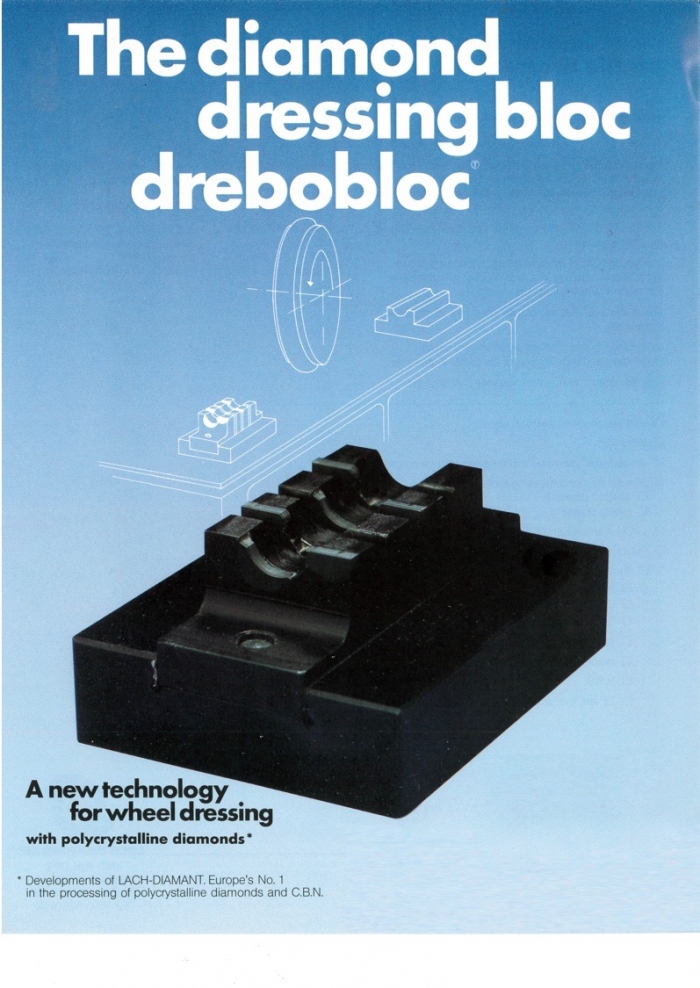
Comma or no Comma
In my opinion, this approach was absolutely right. If only we would already have had today’s computer power and programming abilities in the mid 1980s. Of course, I kept pondering the issue. Comma or no comma, simply put, the real “issue” originated from the nature of milling: There was a chip space between each pair of successive teeth; after
this type of mill dressing this space imprint would more or less show on the grinding wheel. Why not fill the gap between the individual PCD teeth with diamond, and in this case, tightly attached to the body?
No sooner said than done
The result was a patent application on Feb. 6, 1985, with the simple title “dressing tool” – short description: “The
invention relates to a profiled dressing tool, a dressing roll in particular, for rotating grinding tools with an effective, surface consisting of seattered hard grains.”
Many other development steps preceded the final result which was first introduced in 2015 under the name of drebojet-plus. Today’s drebojet-plus diamond rolls incorporate all of them.
Today, the actual PCD milling tooth of the original drebojet roll, serves as stabilizer in the current dressing roll, coated with diamond grain. Usually, its modern design makes re-profiling (service), for example during path-controlled dressing of grinding wheels, unnecessary.
Now, finally, the aforementioned additional success story relating to mill dressing. In any case an economic success story for Lach Diamant. With the support of former manufacturers of PCD, Lach Diamant’s innovations (patent applications) and pioneering achievements had become a topic of interest, such as the development of spark erosion EDM/EDG for machining PCD and the new technology of “mill dressing of grinding wheels.”
Thus, in March 1982, the Japanese diamond tool manufacturer Asahi Diamond Industrial Co, Ltd., under president Arihisa Tanaka, signed a license agreement for both technologies. This provided the base investment for the new company headquarters building in Donaustrasse in Hanau where we moved in 1984.
Related Glossary Terms
- cubic boron nitride ( CBN)
cubic boron nitride ( CBN)
Crystal manufactured from boron nitride under high pressure and temperature. Used to cut hard-to-machine ferrous and nickel-base materials up to 70 HRC. Second hardest material after diamond. See superabrasive tools.
- cutting speed
cutting speed
Tangential velocity on the surface of the tool or workpiece at the cutting interface. The formula for cutting speed (sfm) is tool diameter 5 0.26 5 spindle speed (rpm). The formula for feed per tooth (fpt) is table feed (ipm)/number of flutes/spindle speed (rpm). The formula for spindle speed (rpm) is cutting speed (sfm) 5 3.82/tool diameter. The formula for table feed (ipm) is feed per tooth (ftp) 5 number of tool flutes 5 spindle speed (rpm).
- dressing
dressing
Removal of undesirable materials from “loaded” grinding wheels using a single- or multi-point diamond or other tool. The process also exposes unused, sharp abrasive points. See loading; truing.
- electrical-discharge machining ( EDM)
electrical-discharge machining ( EDM)
Process that vaporizes conductive materials by controlled application of pulsed electrical current that flows between a workpiece and electrode (tool) in a dielectric fluid. Permits machining shapes to tight accuracies without the internal stresses conventional machining often generates. Useful in diemaking.
- gang cutting ( milling)
gang cutting ( milling)
Machining with several cutters mounted on a single arbor, generally for simultaneous cutting.
- grinding
grinding
Machining operation in which material is removed from the workpiece by a powered abrasive wheel, stone, belt, paste, sheet, compound, slurry, etc. Takes various forms: surface grinding (creates flat and/or squared surfaces); cylindrical grinding (for external cylindrical and tapered shapes, fillets, undercuts, etc.); centerless grinding; chamfering; thread and form grinding; tool and cutter grinding; offhand grinding; lapping and polishing (grinding with extremely fine grits to create ultrasmooth surfaces); honing; and disc grinding.
- grinding machine
grinding machine
Powers a grinding wheel or other abrasive tool for the purpose of removing metal and finishing workpieces to close tolerances. Provides smooth, square, parallel and accurate workpiece surfaces. When ultrasmooth surfaces and finishes on the order of microns are required, lapping and honing machines (precision grinders that run abrasives with extremely fine, uniform grits) are used. In its “finishing” role, the grinder is perhaps the most widely used machine tool. Various styles are available: bench and pedestal grinders for sharpening lathe bits and drills; surface grinders for producing square, parallel, smooth and accurate parts; cylindrical and centerless grinders; center-hole grinders; form grinders; facemill and endmill grinders; gear-cutting grinders; jig grinders; abrasive belt (backstand, swing-frame, belt-roll) grinders; tool and cutter grinders for sharpening and resharpening cutting tools; carbide grinders; hand-held die grinders; and abrasive cutoff saws.
- grinding wheel
grinding wheel
Wheel formed from abrasive material mixed in a suitable matrix. Takes a variety of shapes but falls into two basic categories: one that cuts on its periphery, as in reciprocating grinding, and one that cuts on its side or face, as in tool and cutter grinding.
- milling
milling
Machining operation in which metal or other material is removed by applying power to a rotating cutter. In vertical milling, the cutting tool is mounted vertically on the spindle. In horizontal milling, the cutting tool is mounted horizontally, either directly on the spindle or on an arbor. Horizontal milling is further broken down into conventional milling, where the cutter rotates opposite the direction of feed, or “up” into the workpiece; and climb milling, where the cutter rotates in the direction of feed, or “down” into the workpiece. Milling operations include plane or surface milling, endmilling, facemilling, angle milling, form milling and profiling.
- milling cutter
milling cutter
Loosely, any milling tool. Horizontal cutters take the form of plain milling cutters, plain spiral-tooth cutters, helical cutters, side-milling cutters, staggered-tooth side-milling cutters, facemilling cutters, angular cutters, double-angle cutters, convex and concave form-milling cutters, straddle-sprocket cutters, spur-gear cutters, corner-rounding cutters and slitting saws. Vertical cutters use shank-mounted cutting tools, including endmills, T-slot cutters, Woodruff keyseat cutters and dovetail cutters; these may also be used on horizontal mills. See milling.
- milling machine ( mill)
milling machine ( mill)
Runs endmills and arbor-mounted milling cutters. Features include a head with a spindle that drives the cutters; a column, knee and table that provide motion in the three Cartesian axes; and a base that supports the components and houses the cutting-fluid pump and reservoir. The work is mounted on the table and fed into the rotating cutter or endmill to accomplish the milling steps; vertical milling machines also feed endmills into the work by means of a spindle-mounted quill. Models range from small manual machines to big bed-type and duplex mills. All take one of three basic forms: vertical, horizontal or convertible horizontal/vertical. Vertical machines may be knee-type (the table is mounted on a knee that can be elevated) or bed-type (the table is securely supported and only moves horizontally). In general, horizontal machines are bigger and more powerful, while vertical machines are lighter but more versatile and easier to set up and operate.
- parallel
parallel
Strip or block of precision-ground stock used to elevate a workpiece, while keeping it parallel to the worktable, to prevent cutter/table contact.
- polycrystalline diamond ( PCD)
polycrystalline diamond ( PCD)
Cutting tool material consisting of natural or synthetic diamond crystals bonded together under high pressure at elevated temperatures. PCD is available as a tip brazed to a carbide insert carrier. Used for machining nonferrous alloys and nonmetallic materials at high cutting speeds.
- polycrystalline diamond ( PCD)2
polycrystalline diamond ( PCD)
Cutting tool material consisting of natural or synthetic diamond crystals bonded together under high pressure at elevated temperatures. PCD is available as a tip brazed to a carbide insert carrier. Used for machining nonferrous alloys and nonmetallic materials at high cutting speeds.
- profiling
profiling
Machining vertical edges of workpieces having irregular contours; normally performed with an endmill in a vertical spindle on a milling machine or with a profiler, following a pattern. See mill, milling machine.
- surface grinding
surface grinding
Machining of a flat, angled or contoured surface by passing a workpiece beneath a grinding wheel in a plane parallel to the grinding wheel spindle. See grinding.

